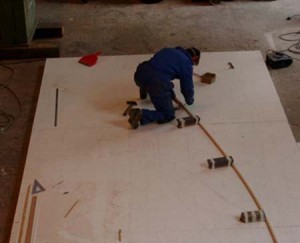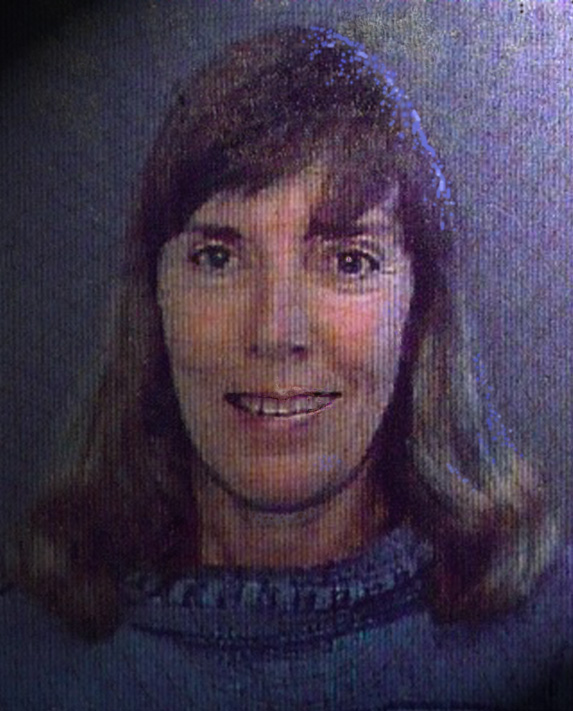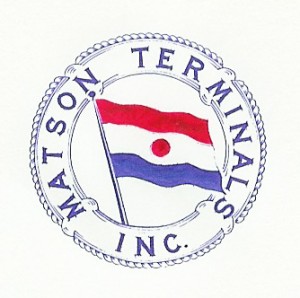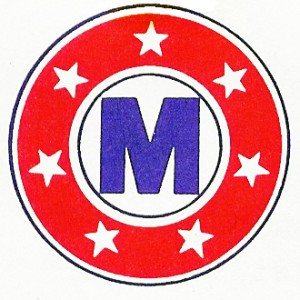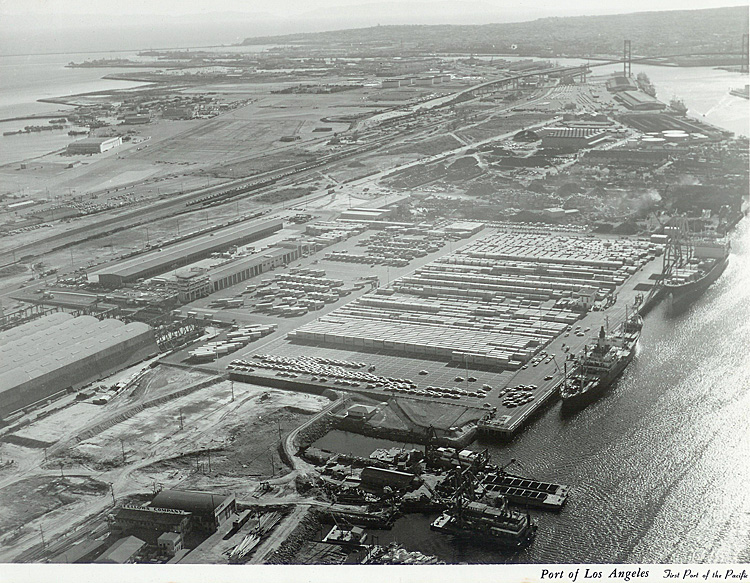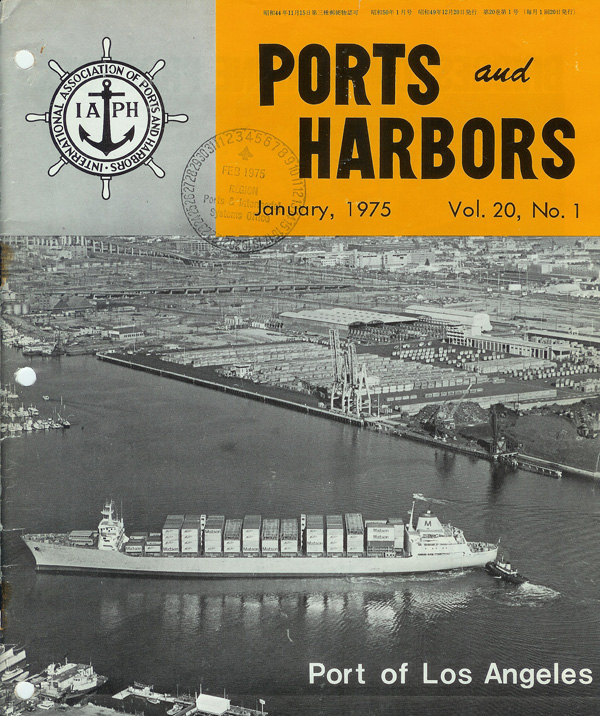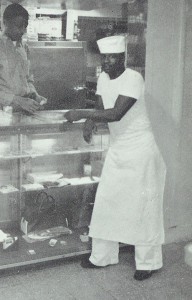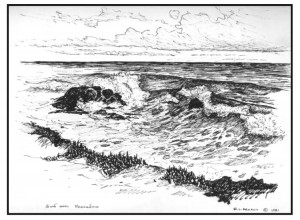Archive for February, 2010
2. STARSHINE Design on Matson Time
As indicated in an earlier post (click here and scroll down to “2. Sinking Beer Cans”), my buddy Doug and I both worked for Matson Navigation Company in their Industrial Engineering Department. This enabled us to plan our restoration of the GAMBELLA in detail on company time. Eventually, however, Doug got ambitions to build a much larger boat, and I bought out his share of the GAMBELLA to help finance his efforts in that regard.
Doug had two main criteria for his new boat. He wanted it to have a flush deck with no visible cabin, and he wanted it to have full headroom below for himself. Doug was about a half inch taller than me — almost six foot three inches. So that, together with the flush deck requirement, dictated a design for a rather large boat. The STARSHINE, as she was eventually named, measured fifty-six feet on deck.
Doug was intent on designing and building this boat himself. In designing a vessel, making a drawing or even a scale model, may be the easy part. The problem is that a considerable error in measurements can accumulate in scaling up the plan. The traditional way to avoid this error is to lay out the curves full size on a large floor of some kind. Spaces used for this process were often lofts; hence the practice became known as lofting.
Doug didn’t have access to a loft, but he did have access to the office computer and he was a math major in college. Using a computer-aided process called multiple regression analysis, he managed to fit a mathematical equation to each longitudinal and each cross-section line of his plan. He then set them equal to each other at every place they were supposed to cross to see if they actually did meet at that point. If they didn’t, he modified the equations until they did. Even with the aid of the computer it was a long process that went on for weeks. This was in the early days of office computer systems. The individual terminals were like teletype machines and they all accessed a central processor. The engineers in the department all had their own offices and there was no office network to speak of and, hence, no central oversight on the computer use. If you could hear a terminal running then that engineer was obviously hard at work. I was the only one who knew what Doug was doing and I kept mum about it. Doug also got enough of his assigned work done that no one got suspicious. I left the company to go to work for the Maritime Administration before he finished, but he finally did get it all done. It was quite an impressive effort and everybody thought he worked so hard for Matson.
Evie Photoshopped
Here is a photo with an unusual origin. It came off an old drivers licence and was taken when Evie was somewhere around fifty . I could see that it was a good shot for a drivers licence photo (mine are always laughable), but it was only a little over an inch square and had some kind of a rubber stamped seal over a portion of it. Thinking I might be able to do something with it, I plugged it into Photoshop Elements and started playing. What you see here it the result of several hours work.
Go to http://www.jacketflap.com/profile.asp?member=Eviewilson to see some of her works.
1. Working for Matson
Toward the end of my active duty with the Navy I began to think about what I was going to do with the rest of my life. I went to job interviews at a number of firms in the San Francisco Bay Area, and finally ended up with Matson Terminals, a subsidiary of the steamship operator Matson Navigation Company. Matson Terminals was a stevedore firm (loading and discharging of vessels) and they were the only company I talked to that placed some significance on my Navy experience aboard a cargo vessel. The parent company was mainly involved with interstate commerce, primarily to and from Hawaii and the West Coast, but also Guam and other Pacific territories. Matson Terminals was the stevedore for the parent company, but also had other “outside” customers as well. The Vietnam war was heating up at the time and Matson Terminals had the contract to do all the stevedore work for the Oakland Army Terminal. The Army Terminal was all conventional cargo, but Matson, in general, was a pioneer on the West Coast for containerized cargo traffic. At the time there was only one container crane in the SF Bay Area and that was in Alameda, next to the Dole Pineapple warehouses, one of Matson’s big customers. Now, If you drive through the Port of Oakland, for instance, you can see container canes from horizon to horizon.
I had a split tour with Matson, working for Terminals for two years before trying my hand at the electronics industry in Silicon Valley for a couple of years. Then it was back to the parent company Matson Navigation for another four years. My combined tenure with Matson was in their Industrial Engineering Department. In general, the work was not very exciting or creative. It was usually, “fix this problem here” or “come up with a solution to that problem there.”
There was, however, one project that I remember distinctly as being quite satisfying from start to finish. It was the design and construction of a brand-new container terminal in the Port of Los Angels starting with approximately fifty acres of vacant land and ending with a state-of-art container terminal. As I remember, the project ran on for well over a year and I was the principal engineer for Matson in charge of the conceptual design. I had to deal regularly with the civil engineers at the Port of Los Angeles who did the detailed “stress and strain” work. I became a regular commuter between SF and LA, sometimes flying back and forth two, or even three times, a week. I was very proud of the final result. It was impressive, and I remember thinking “This is without a doubt the best marine container terminal in the world.” It did make the industry news worldwide. Here are two aerial photographs of the completed terminal:
6. The Ney Award
In WESTPAC there was an honor awarded each year called the Ney Award. It was for the best feeding ship in WESTPAC. I have no idea how this award originated but, as I remember, the PICTOR was given the award for several years running during my tour aboard. Of course, we were a floating grocery store, and that gave us a leg up on most of the other ships in the fleet. There were, however, a number of other AFs (Auxhilary Refridgerated) in WESTPAC, so what made the PICTOR so special?
Frankly, I am not surprised we received this honor. The food was quite good aboard our ship. In addition, and this may seem counter-intuitive, the enlisted mess was better than the officer’s mess. They had better cooks than we did. In the officer’s mess all the cooking was done by the stewards and they were, to a man, all of Filipino descent. They were good sailors, obedient and conscientious, which is why they made good stewards. Had they been allowed to cook in their native tradition our food might have been more exciting, but they faithfully followed the standard Navy cookbook and its recipes. That book was not a work of art from a culinary point of view, but it did make a point of supplying recipes from all the different regions of the United States. The first time I ever ate okra, a traditional Southern vegetable, was in the ward room of the PICTOR.
I frequently heard grumbling among the officers about the quality of our grub, but I never once heard such a complaint from the rest of the crew. In fact, it was just the opposite, I often heard the sailors say good things about their cooks. Navy regulations required every meal served in the enlisted mess to be sampled by an officer, and this was a duty that we actually looked forward to.
How did this unique situation come about? Who gets the credit? Well, I was not a party to all the goings on behind the scenes, but the name I heard mentioned the most was a First Class Cook named Eddie Moton. My cruise book says that Moton was from Oakland, but I seem to remember that he was originally from Texas. Moton was something of a culinary artist, plain and simple, and that kind of artistry is a difficult thing to maintain when cooking three meals a day for 200 men. He was especially good at barbecue, and his barbecued ribs were to die for. If you were the officer who had the duty to sample the crew’s mess when Moton was barbecuing ribs you were the envy of wardroom; and if you used this as a bargaining chip there is no telling what you might obtain in trade.
(click on image for larger view)
So, in my book, the PICTOR’s success with the Ney Award is directly attributable to First Class Cook Eddie Moton and his crew.
For the final chapter of my experience with the USS PICTOR click here.
29. The Surf Near Pescadero
pen and ink 8 1/2 x 12
(click on image for larger view)
One of many sketches done of surf and rocks along the San Mateo County coast.
5. Mary Soo
Mary Soo was one of the more remarkable individuals whose path crossed mine. She and her crew of mostly women would contract to paint an entire Navy ship while it was anchored at Hong Kong. Hong Kong was always the high point of every WESTPAC cruise, liberty was generously granted. One of the things that made this possible was Mary Soo and her outfit. Typically, we would stop in Hong Kong for a full week of rest and recreation (R&R).
Here is a panorama of Hong Kong harbor showing Navy ships anchored out in the bay —there were no port facilities:
Upon arrival Mary Soo or one of her lieutenants would come aboard and work out a deal to paint the ship. Sometimes she would do the job just for the right to the garbage from the ship’s messes. Because Hong Kong was a liberty port, and a good portion of the crew was ashore at any one time, much of the food prepared aboard ship went unconsumed. This was carefully packaged and turned over to Mary Soo who sold it here and there in the city. It was sometimes wryly observed by seasoned salts that food purchased by sailors ashore might have been had for free aboard ship.
Because Navy regulations prohibited paying foreign nationals in cash for work accomplished on the ship, other means of compensation had to be found. Garbage was one solution, but the PICTOR was quite experienced in these matters, and we would usually load up with war surplus scrap metal in the Phillipines before proceeding to Hong Kong. Mary Soo was always delighted to see all of that stuff, especially if there was brass invovled.
After the deal was completed, a small fleet of sampans would arrive and an army of mostly women would file aboard to start painting. We provided the paint and they did the work. One reason that most of them were women was because Mary Soo also ran an orphange. She would “buy” unwanted female children and raise them in her orphnage. She probably saved the lives of many girl babies in this way. When the chilren were old enough to work they would join the ship painting effort. As workers they were paid a small wage, but this was put into an account for them which they would receive in full upon reaching adulthood. After that they could stay with Mary Soo or make their own way in the world. Sometimes some of the small children would accompany their older counterparts out to the ship. They didn’t actually come aboard but would stay on the sampans alongside. I remember on one occasion looking over the side and watching several girls of about age five or six playing on the stern of one of the boats. One of the girls was blond and fair. Needless to say that was highly unusual. I wasn’t close enough to see her facial features, but she was speaking fluent Chinese. I assume she was one of Mary Soo’s orphans.
The workers were always dressed in ragged, paint-covered clothes and they all wore the conical coolie hat as protection from the Sun. It was almost impossible to tell what they looked like. Instead of brushes, they used rags or textile waste to spread the paint. The few men there were used long poles to paint the sides of the ship from sampans moored alongside. They were a good natured bunch and there was much laughing and joking between the girls and the PICTOR’s deck force.
Because the PICTOR was such a good paying ship, May Soo always threw a big party for us at the end of the week. It was at this party that I first saw Mary Soo in person. She looked to be about eighty years old at the time (1963), yet she was obviously a very shrewd business person. The big surprise at the party, however, was the girls — they were gorgeous! They all wore their best party dresses, had their hair done and their makeup on. Our first reaction was these can’t be the same girls that painted the ship, but they were.
Several years after I left active duty I read in the newspaper that Mary Soo had died. It made the news all over the world.
Categories
- THE GALLERY
- Uncle Rob's Art
- 3D Works (stills) I
- 3D Works (stills) II
- 3D Works (stills) III
- 3D Works (video)
- Design & Abstract I
- Design & Abstract II
- Design & Abstract III
- Figurative Works I
- Figurative Works II
- Landscapes I
- Landscapes II
- Largest Art Project
- Nautical and Marine Images (video)
- Nautical and Marine Images I
- Nautical and Marine Images II
- Nautical and Marine Images III
- Nautical and Marine Images IV
- Portraits
- Still Life Images
- Stump Hollow Photo Essay I
- Stump Hollow Photo Essay II
- Uncle Rob's Mendocino Shop
- The Five Sense Series
- Irene's Creations
- Works by Don Mason
- Works by Don Mason II
- Works by Joseph de Borde
- Painting by Albert Robbins
- Art by Leslie Masters Villani
- Paintings by Nellie Harriet Parker
- The Art of Bee Yearian
- Works by Evie Wilson
- Uncle Rob's Art
- SCHOONER MOON BOOKS
- SEA STORIES
- ONE DOZEN AND TWO ESSAYS
- Cousinhood
- Art by Definition
- Cake Mixed Economy
- Marriage Anyone?
- Sex and/or Violence
- Searching for Truth
- The Philosophical Roots of Science
- Stepping Stones and Stumbling Blocks
- On Being Good
- Teaching By Example
- The Basic Law of Civilization
- Where Goeth Evil?
- A Modern Empircal "Religion"
- Knowledge as Wealth
- PAPERS AND ARTICLES
- FAMILY STORIES
- BOOK REVIEWS
Archive
- December 2021
- October 2020
- June 2020
- September 2019
- July 2017
- March 2017
- December 2016
- November 2016
- October 2016
- August 2016
- July 2016
- June 2016
- May 2016
- March 2016
- February 2016
- February 2015
- January 2015
- February 2014
- December 2013
- November 2013
- August 2013
- June 2013
- August 2012
- July 2012
- April 2012
- March 2012
- February 2012
- November 2011
- September 2011
- June 2011
- May 2011
- April 2011
- March 2011
- February 2011
- January 2011
- December 2010
- November 2010
- October 2010
- September 2010
- August 2010
- July 2010
- June 2010
- May 2010
- April 2010
- March 2010
- February 2010
- January 2010
- December 2009
- November 2009
- October 2009
- September 2009
- August 2009
- July 2009
- June 2009
- May 2009
- April 2009
- March 2009
- February 2009
- January 2009
- December 2008
- November 2008
- October 2008
- September 2008
